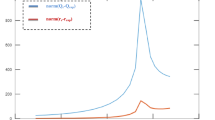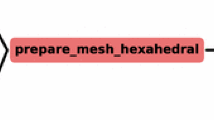Abstract
Inverse solution techniques based on electroencephalograph (EEG) measurements have become a powerful means of gaining knowledge about the functioning of the brain. A model of the head and a potential computation method are necessary to describe the EEG problem mathematically. The generation of realistically shaped three-compartment models of the head is discussed. The isolated problem approach for the boundary element method is applied to develop a fast and accurate numerical solution of the EEG forward problem. Accuracy studies with this approach show that dipole positions can be reconstructed within a distance of 3 mm from the original positions. Inverse simulations indicate that the incorporation of the individual head shape may significantly influence the reconstructed dipole position but not its magnitude and orientation, in comparison with the commonly used three-sphere model. However, the presence of noise in the simulated potential data affects the solutions based on realistically shaped models more than those of the simple three-sphere model. The increased censitivity of the former models to noise in the data remains a serious drawback for their practical application to EEG source localisations.
Similar content being viewed by others
References
Barr, C., Ramsey, III, M., andSpach, M. S. (1977): ‘Relating epicardial to body surface potential distributions by means of transfer coefficients based on geometry measurements’,IEEE Trans.,BME-24, (1), pp. 1–11
Meljs, J. W. H., Weier, O. W., Peters, M. J., andvan Oosterom, A. (1989): ‘On the numerical accuracy of the boundary element method’,IEEE Trans.,BME-36, (10), pp. 1038–1049
Bertrand, O., Thevenet, M., andPerrin, F. (1991): ‘3D finite element method in brain electrical activity studies’in Nenonen, J., Rajala, H. M., andKatila, T. (Eds.) ‘Biomagnetic localization and 3D modelling’. Helsinki University of Technology, Department of Technical Physics, Report TKK-F-A689, pp. 154‐171
Cuffin, B. N. (1990): ‘Effects of head shape on EEG’s and MEG’s’,IEEE Trans.,BME-37, (1), pp. 44–52
de Munck, J. C. (1992): ‘A linear discretization of the volume conductor boundary integral equation using analytically integrated elements’,IEEE Trans.,BME-39, (9), pp. 986–990
Engeln-Müllges, G., andReutter, F. (1990): ‘Formelsammlung zur numerischen Mathematik mit C-Programmen’ (BI Widdenschaftsverlag, Mannheim/Wien/Zürich) pp. 245–270
Geselowitz, D. B. (1967): ‘On the bioelectric potentials in an inhomogeneous volume conductor’,Biophys. J.,7, pp. 1–11
Hämäläinen, M. S., andSarvas, J. (1989): ‘Realistic conductivity geometry model of the human head for interpretation of neuromagnetic data’,IEEE Trans.,BME-36, (2), pp. 165–171
Heller, L. (1990): ‘Computation of the return current in encephalography: the auto solid angle’in Gmitro, A. F., Idell, P. S., andLaHaie, I. J. (Eds.): ‘Digital imaging and inverse optics’. Proc. SPIE 1251, pp. 376–390
Lynn, M. S., andTimlake, W. P. (1967): ‘The use of multiple deflations in the numerical solution of singular systems of equations, with applications to potential theory’,SIAM J. Num. Anal.,5, (2), pp. 303–322
Mosher, J. C., Lewis, P. S., andLeahy, R. M. (1992): ‘Multiple diode modeling and localization from spatio-temporal MEG data’,IEEE Trans.,BME-39, (6), pp. 541–557
Roth, B. J., Balish, M., Gorbach, A., andSato, S. (1993): ‘How well does a three-sphere model predict positions of dipoles in a realistically shaped head?’Electroenceph. Clin. Neurophysiol.,87, pp. 175–184
Wieringa, H. J. (1993): ‘MEG, EEG and the integration with magnetic resonance images’. PhD Thesis, University of Twente, The Netherlands
Wieringa, H. J., andPeters, M. J. (1993): ‘Processing MRI data for electromagnetic source imaging’,Med. Biol. Eng. Comput., 1993,31, pp. 600–606
Zhou, H., andvan Oosterom, A. (1992): ‘Computation of the potential distribution in a four-layer anisotropic concentric spherical volume conductor’,IEEE Trans.,BME-39, (2), pp. 154–158
Author information
Authors and Affiliations
Rights and permissions
About this article
Cite this article
Zanow, F., Peters, M.J. Individually shaped volume conductor models of the head in EEG source localisation. Med. Biol. Eng. Comput. 33, 582–588 (1995). https://doi.org/10.1007/BF02522518
Received:
Accepted:
Issue Date:
DOI: https://doi.org/10.1007/BF02522518




